(houseofbhakti.com) – Damodar Vrata | House of Bhakti
Dāmodara-vrata begins tomorrow. Dāmodara-vrata, ūrja-vrata, kārtika-sevā and niyama-sevā-vrata are all the same. We are going to follow this vrata from tomorrow. It commences from either the Ekādaśī after Vijayā Daśamī, or from the Dvadaśī; or from the Purṇimā; and accordingly, it is completed on the last Ekādaśī of Caturmāsya, that is, Utthāna Ekādaśī, or Dvadaśī, or Purṇimā. It will be totally completed on Purṇimā. Those who commenced on Ekādaśī or Dvadaśī should also do this vrata until Purṇimā. The last five days are called Bhīṣma Pañcaka.
When I joined Śrī Gauḍīya Vedānta Samiti, our holy master, nitya-līlā-praviṣṭa oṁ viṣṇupāda aṣṭottara-śata Śrī Śrīmad Bhakti Prajñāna Keśava Gosvāmī Mahārāja was performing this kārtika-vrata in any one of the sacred places, like Vṛndāvana, Navadvīpa, Purī, Kurukṣetra, and even Dvārakā, Ayodhyā, Naimiṣāraṇya and Haridvāra.
There are some rules and regulations concerning this dāmodara-vrata given in Śrī Hari-bhakti-vilāsa and other authentic Vedic literatures. Every day, in the morning or evening, we should sing Dāmodarāṣṭaka. For the whole month we should be like brahmacārīs, only eating very simple mahā-prasādam. There are also some rules and regulations for honouring mahā-prasādam. We should not take those things that are to be avoided for this month. For example, we should not take mustard oil, bottle gourd (laukī) or urad dāl. We should not tell lies; we should try to speak the truth. We should try not to criticize anyone. Always chant harināma, in a regular way, with regular counting.
Our gurudeva used to say that caturmāsya-vrata is not given in the sixty-four limbs of bhakti, but that ūrja-vrata has been given. Ūrja-vrata is part of caturmāsya-vrata. We should totally follow the four months of caturmāsya-vrata, and we should especially try to follow this dāmodara-vrata very carefully. There are so many persons who do not follow caturmāsya-vrata, and, therefore, they are actually not following Śrī Caitanya Mahāprabhu. Wherever Caitanya Mahāprabhu went, He followed caturmāsya-vrata. We see that when He went to Raṅganātha 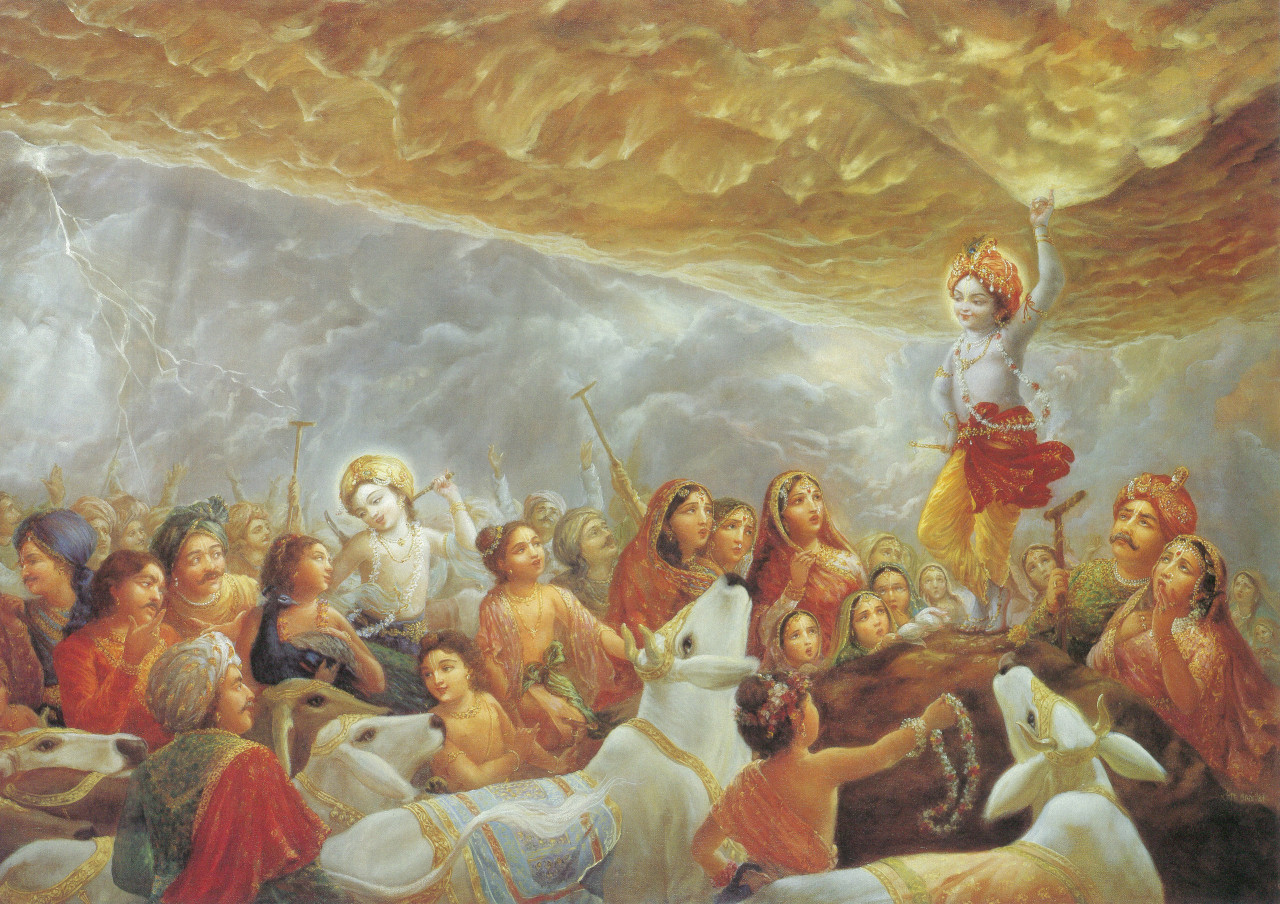 temple in South India, for example, He followed caturmāsya-vrata there.
temple in South India, for example, He followed caturmāsya-vrata there.
In this month of Kārtika, Kṛṣṇa lifted Govardhana. It was also in this month that Yaśodā tied up Kṛṣṇa. She is seen taking a stick in her hand, warning Kṛṣṇa, and Kṛṣṇa is weeping. Although He is the Supreme Personality of Godhead, when He saw that Yaśodā Maiyā was coming to beat Him with a stick, He told her, “I will not do it again, Mother. Forgive Me.” He began to weep and He was not pretending. He really began to weep. He had forgotten His supremacy.
Yaśodā Maiyā is an eternal associate of Kṛṣṇa, His eternal mother, and she is beyond the influence of the māyā. Due to the influence of Yogamāyā, however, she has forgotten that Kṛṣṇa is the Supreme Personality of Godhead. By taking Kṛṣṇa’s name inattentively or carelessly, with no regard or honour, while falling down on the earth – in any way – if one chants the name you will come out of māyā. That same Kṛṣṇa creates millions and millions of worlds. Yet, thinking Kṛṣṇa her own son, she forgets that He is the Supreme Personality of Godhead,  and she is ready to punish Him.
and she is ready to punish Him.
Kṛṣṇa somehow escaped from His mother. He ran away on the very broad road, and she pursued Him. Brahmā, Śaṅkara and all the lords of lords, cannot catch Kṛṣṇa even by their pure minds. And great demons like Jarāsandha certainly cannot catch Him. But Yaśodā Maiyā is a gopī and the mother of Kṛṣṇa. She wanted to catch hold of Him, and since she was able to run faster than Kṛṣṇa, she caught Him.
What is the meaning? Kṛṣṇa’s associates love Kṛṣṇa, and Kṛṣṇa also loves them. If anyone loves Kṛṣṇa more than He loves him, then Kṛṣṇa will be caught. Otherwise not. So Yaśodā Maiyā was able to run faster than Kṛṣṇa, and thus she caught hold of Him. Kṛṣṇa began to weep, “Mother, spare Me, spare Me. I will not make this mistake again.” This pastime began when Yaśodā Mā was churning yoghurt. Kṛṣṇa had been sleeping and woke up crying, “Where is Mother? Where is Mother?” She took Kṛṣṇa in her lap and began to give Him her breast milk. Then, seeing that the milk on the stove was about to boil over onto the fire, Yaśodā put Kṛṣṇa down and jumped up to save the milk. Kṛṣṇa became angry, and He broke the pot of yoghurt. After this, Yaśodā began to bind Him. This pastime took place in this month.
Gopāṣṭamī also falls in this month. At the beginning of Kṛṣṇa’s paugaṇḍa age, at the age of five, He begins gocāraṇa, cow-herding from Nandagāon. Initially, He took the little calves for grazing. When He became older, He took the cows.
The most important pastime of Kṛṣṇa and the gopīs, rāsa-līlā, began in this month. In fact, tomorrow is Śāradīya 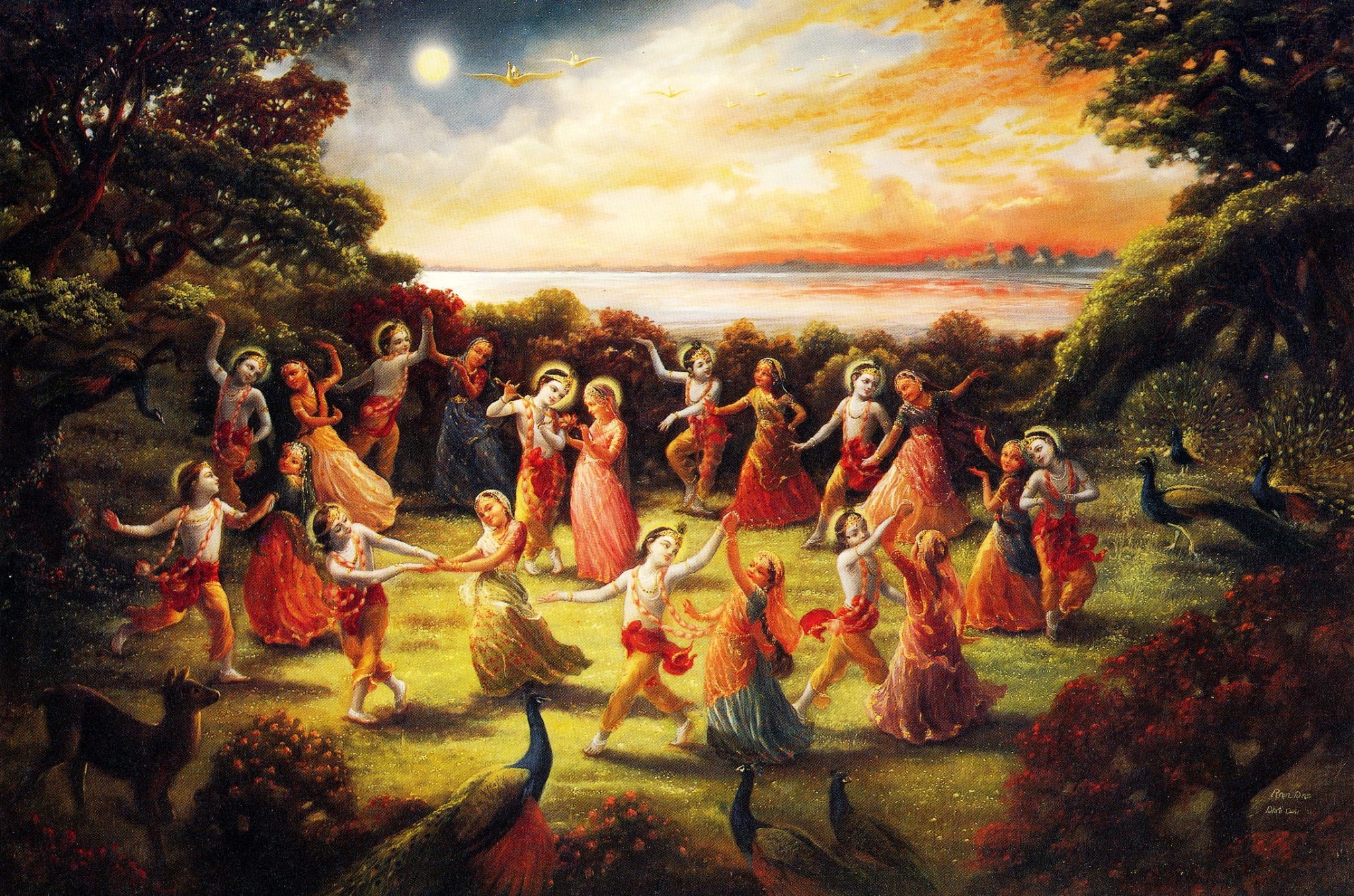 Purṇimā, the first day of Kārtika. Of all the pastimes of Kṛṣṇa, this śāradīya-rāsa is the most special. Kṛṣṇa began to play on His flute on this day, on Purṇimā, at the beginning of the night, and thus rāsa was performed. When Kṛṣṇa disappeared from the rāsa-maṇḍala, the gopīs were weeping and searching for Him. “Where is Kṛṣṇa? Where is Kṛṣṇa?” They began to ask the trees where Kṛṣṇa was. “Where is Kṛṣṇa?” they cried. “Do you know, O Tulasī tree, where Kṛṣṇa is?” Śrīmad-Bhāgavatam explains that the gopīs’ mood of separation at this time was such that they became one with Kṛṣṇa, [and perceived themselves to be in His līlā.] This special līlā was performed for the duration of one night of Brahmā, and at the same time it appeared within one of our nights.
Purṇimā, the first day of Kārtika. Of all the pastimes of Kṛṣṇa, this śāradīya-rāsa is the most special. Kṛṣṇa began to play on His flute on this day, on Purṇimā, at the beginning of the night, and thus rāsa was performed. When Kṛṣṇa disappeared from the rāsa-maṇḍala, the gopīs were weeping and searching for Him. “Where is Kṛṣṇa? Where is Kṛṣṇa?” They began to ask the trees where Kṛṣṇa was. “Where is Kṛṣṇa?” they cried. “Do you know, O Tulasī tree, where Kṛṣṇa is?” Śrīmad-Bhāgavatam explains that the gopīs’ mood of separation at this time was such that they became one with Kṛṣṇa, [and perceived themselves to be in His līlā.] This special līlā was performed for the duration of one night of Brahmā, and at the same time it appeared within one of our nights.
It was also in this very month that Uddhava went to Nandagāon, Vraja, and tried to console the gopas, gopīs, 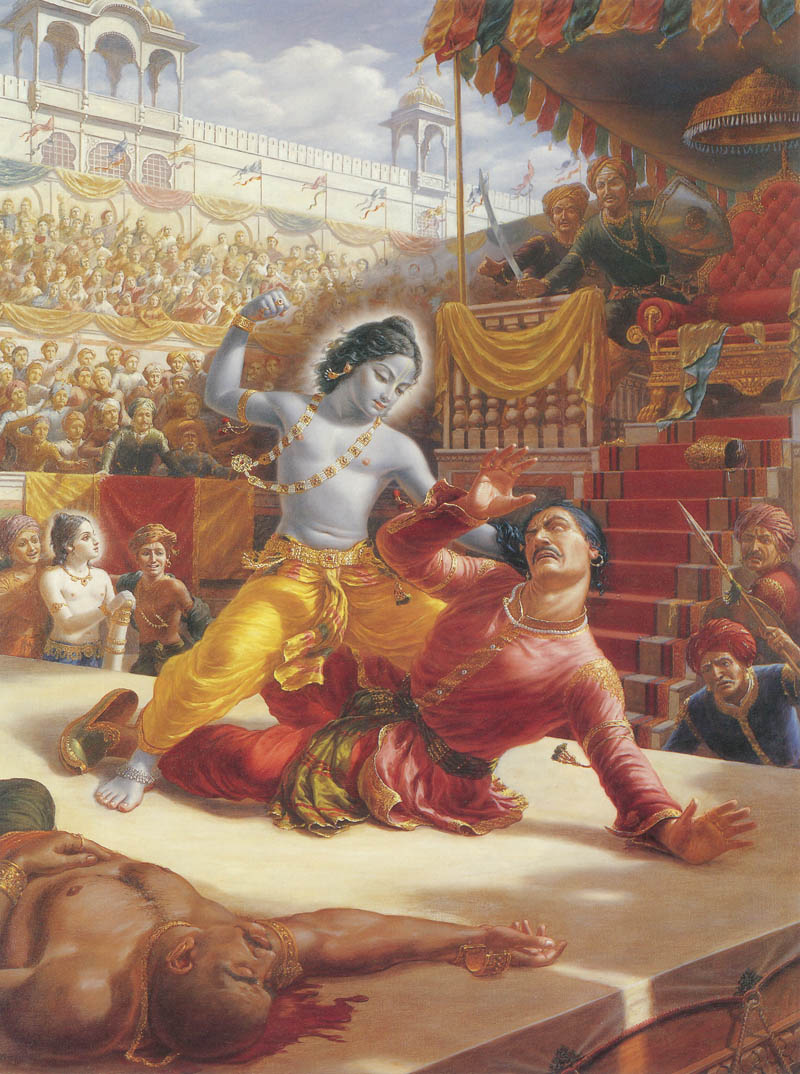 Nanda Bābā and all other Vrajavāsīs. And finally, it was in this month that Kaṁsa sent Akrūra to bring Kṛṣṇa and Balarāma from Nandagāon to Mathurā. Kṛṣṇa left Nandagāon and Vraja, came to Mathurā and killed Kaṁsa nearby, at Kaṁsa-ṭīlā. In this way, all the prominent pastimes of Kṛṣṇa were performed in this month.
Nanda Bābā and all other Vrajavāsīs. And finally, it was in this month that Kaṁsa sent Akrūra to bring Kṛṣṇa and Balarāma from Nandagāon to Mathurā. Kṛṣṇa left Nandagāon and Vraja, came to Mathurā and killed Kaṁsa nearby, at Kaṁsa-ṭīlā. In this way, all the prominent pastimes of Kṛṣṇa were performed in this month.
This month is called Dāmodara māsa (month), or Ūrja māsa, and there is a reason for this. Kṛṣṇa was controlled by Rādhikā in this month and He became Dāmodara-Kṛṣṇa. There are two Dāmodaras: Yaśodā-Dāmodara and Rādhā-Dāmodara. The pastimes related to both these names took place in this prominent month.
In our Gauḍīya Vaiṣṇava sampradāya, although we worship Yaśodā-Dāmodara, Rādhā-Dāmodara is prominent. Śrīla Sanātana Gosvāmī has explained this in a very hidden way. In fact, in all their ṭīkās (commentaries) of Śrīmad-Bhāgavatam, our ācāryas have also explained it in a hidden way. Śrīla Sanātana Gosvāmīpāda and our guru mahārāja have warned us not to reveal these hidden facts openly before the public. They are the heart and soul of advanced devotees and are not meant for the general masses. That is why Śrī Śukadeva Gosvāmī has not spoken the name of Śrīmatī Rādhikā in Śrīmad-Bhāgavatam. Attaining love for Rādhā-Dāmodara is the only aim and object of our sādhana-bhajana and everything else we do.
I want to tell you the speciality of the name Dāmodara. This month is called Kārtika. Śrīmatī Rādhikā is the iṣṭa-devī, the predominating or worshipful deity, of this month. As you know, Puruṣottama-Kṛṣṇa is the special deity of Puruṣottama māsa. Similarly, Śrīmatī Rādhikā is the presiding deity of this month, and therefore, it is called the month of Dāmodara. Rādhā-Dāmodara līlā and Yaśodā-Dāmodara līlā were both performed in this month, and Śrī Kṛṣṇa became controlled by their heart. Even Nārada, Uddhava, Brahmā and Śaṅkara cannot control Kṛṣṇa. He performed these līlās in order to show them that He may be controlled by Yaśodā Maiyā, the Vrajavāsīs and the gopīs.
itīdṛk sva-līlābhir ānanda-kuṇḍe
sva-ghoṣaṁ nimajjantam ākhyāpayantam
tadīyeśita-jñeṣu bhaktair jitatvaṁ
punaḥ prematas taṁ śatāvṛtti vande
Śrī Dāmodarāṣṭakam (3)
[By His childhood pastimes such as this dāma-bandhana-līlā, He perpetually drowns all the residents of Gokula – His gopas, gopīs, cows, calves and so forth, who are all manifested by His pastime potency – in pools of bliss. He thus informs those who have knowledge of His absolute divinity that only the pure and simple love of these devotees can conquer Him. Again, hundreds of times, I offer loving obeisance unto Śrī Dāmodara Kṛṣṇa.]
Kṛṣṇa wanted to show, “I cannot be controlled by Hanumān, Śaṅkara, Prahlāda Mahārāja, or by Satyabhāmā and Rukmiṇī, or even by Uddhava. I can only be controlled by the vraja-bhaktas, like Śrīdāma, Subāla, Madhumaṅgala, Yaśodā Maiyā, Nanda Bābā and all the gopīs, especially the most prominent gopī.”
In this way our guru mahārāja used to say that we should honour the entire caturmāsya-vrata and very carefully 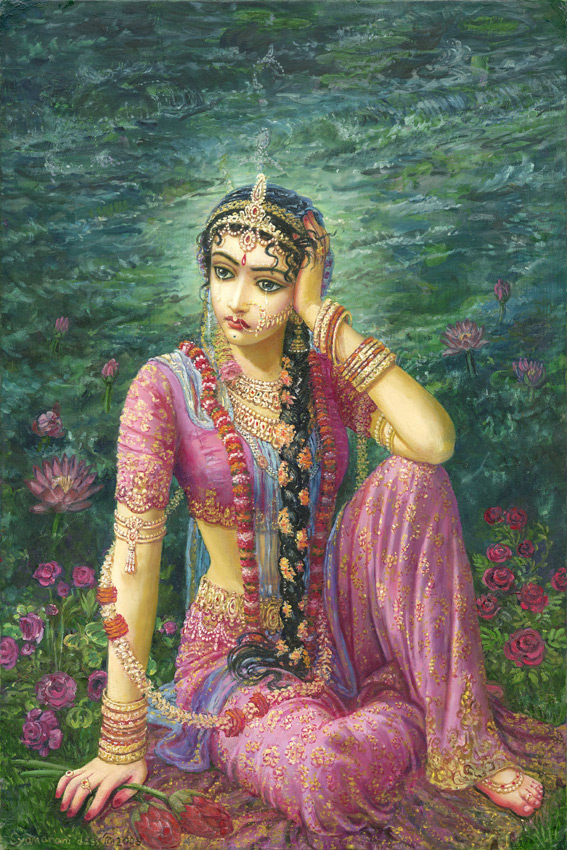 observe this Dāmodara month. This is called ūrja-vrata. What is the meaning of ūrja? Ūrja means power, energy, fire or electricity. In Sanskrit, all these are known as ūrja. Śrīmatī Rādhikā is the iṣṭa-devī of all kinds of ūrja. Even the power of Kṛṣṇa is Rādhikā. Whatever we see in this world or in the spiritual world of Vaikuṇṭha or Goloka Vṛndāvana, all are manifestations of the śakti of Śrīmatī Rādhikā. She is svarūpa-śakti, the internal potency of Kṛṣṇa. Kṛṣṇa can only desire. If He desires anything, Śrīmatī Rādhikā, in so many forms, can fulfil His desire at once. If Kṛṣṇa wants to taste anything, even in thousands of ways, She manifests that thing accordingly and satisfies Him. Satyam paraṁ dhīmahī. The parama satyam, topmost Truth, is Śrīmatī Rādhikā. Dhīmahī – we meditate upon Her. She is the presiding deity of potency (ūrja) and, therefore, this month is called ūrja-vrata. This month is also called kārtika-vrata niyama-sevā.
observe this Dāmodara month. This is called ūrja-vrata. What is the meaning of ūrja? Ūrja means power, energy, fire or electricity. In Sanskrit, all these are known as ūrja. Śrīmatī Rādhikā is the iṣṭa-devī of all kinds of ūrja. Even the power of Kṛṣṇa is Rādhikā. Whatever we see in this world or in the spiritual world of Vaikuṇṭha or Goloka Vṛndāvana, all are manifestations of the śakti of Śrīmatī Rādhikā. She is svarūpa-śakti, the internal potency of Kṛṣṇa. Kṛṣṇa can only desire. If He desires anything, Śrīmatī Rādhikā, in so many forms, can fulfil His desire at once. If Kṛṣṇa wants to taste anything, even in thousands of ways, She manifests that thing accordingly and satisfies Him. Satyam paraṁ dhīmahī. The parama satyam, topmost Truth, is Śrīmatī Rādhikā. Dhīmahī – we meditate upon Her. She is the presiding deity of potency (ūrja) and, therefore, this month is called ūrja-vrata. This month is also called kārtika-vrata niyama-sevā.
In order to attain realizations of these things in the advanced stage, we have to start [the practice by which they will be attained] from the very beginning. Everyone should therefore try to adopt the rules and regulations established by Śrīla Sanātana Gosvāmī, who has written them down in Śrī Hari-bhakti-vilāsa. Śrīla Rūpa Gosvāmī has written them in Śrī Upadeśāmṛta, and Raghunātha dāsa Gosvāmī in Śrī Manaḥ-śikṣā. Try to follow all these practices in the beginning stages, and always be in the good association of Vaiṣṇavas. Our only aim is to attain service to Rādhā-Kṛṣṇa or Rādhā-Dāmodara, Rādhā-Gopīnātha, Rādhā-Madana-mohana, Rādhā-Śyāmasundara. They should be the object of our life, of our whole sādhana and bhajana.
We should be without desires other than those for the service of Lord Kṛṣṇa (anyābhilāṣitā śunyam). There should be no anyābhilāṣa, material desires. No other desires should come in our hearts except for the service of the Divine Couple. Especially in this one month, try to be in the association of realized Vaiṣṇavas.
We are very fortunate that in this month we have the association of parama-pūjyapāda Śrī Śrīmad Bhaktivedānta Trivikrama Mahārāja. He will guide us in our month-long parikramā. Try to follow him. Externally he looks very strict, but you will see that his heart is so soft. I am so fortunate that he is my elder god-brother. I treat him as my śikṣā-guru, just as I do parama-pūjyapāda Śrī Śrīmad Bhaktivedānta Vāmana Mahārāja. Śrīla Trivikrama Mahārāja has given me so much mercy. From the beginning he kept me with him and gave me so much śikṣā, instruction. Sometimes he also rebuked me, and I accepted him as my gurudeva.
Try to follow all the rules and regulations. During this month, daily try to offer a pradīpa, lamp, to Śrī Mūrti and Tulasī-devī. Try to do parikramā of Tulasī-devī daily. If Yamunā is nearby, you can go to her and offer her praṇāma and prayers. If your health permits, you can take a bath, otherwise simply do ācamana. Do not roughly handle any green leaves of trees, and do not step on ants and other insects. Do not kill anything and do not criticize anyone, otherwise your parikramā will be ruined. Always chant harināma and give honour to Vaiṣṇavas. Read Śrī Caitanya-caritāmṛta, Śrīmad-Bhāgavatam, Śrīmad Bhagavad-gītā and all other such books. In this way, try to complete your vrata.
We are praying to our gurudeva, nitya-līlā-praviṣṭa oṁ viṣṇupāda aṣṭottara-śata Śrī Śrīmad Bhakti Prajñāna Keśava Gosvāmī Mahārāja, Śrīla Bhaktisiddhānta Sarasvatī Ṭhākura, our whole disciplic succession, and also to Śrī Śrī Rādhā-Dāmodarajī, that we can complete this Rādhā-Dāmodara month with all its rules and regulations. Tomorrow we will all go to Yamunā for saṅkalpa, to take a vow. We will pray, “O Yamunā-devī, you are the sakhī of Kṛṣṇa and Śrīmatī Rādhikā, and you are especially serving Rādhā-Dāmodara. Be pleased with us so that we can successfully complete this vrata. Govardhana, Rādhā-kuṇḍa, Śyāma-kuṇḍa and all may be merciful to us, so that our ambition to serve Śrī Śrī Rādhā-Dāmodara may be fulfilled.”
Source: Purebhakti.com
Image/Art made possible by Pixabay.com, Krishnapath.org and/or Bhaktiart.net
Unless indicated differently, all verse translations and quotes are from the books by Śrīla Bhaktivedānta Svāmī Mahārāja Prabhupāda (Vedabase.com)
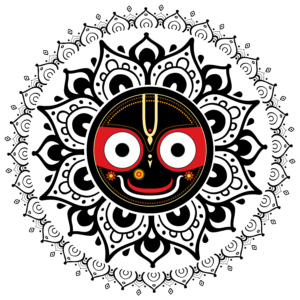
#vrata #House #Bhakti






